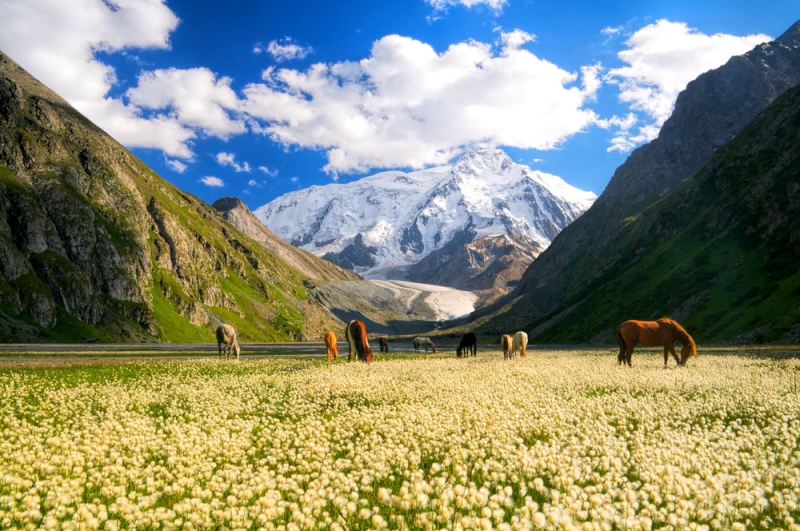
For the beauty of alpine meadows and snowy peaks of the Tien Shan and Pamirs, Kyrgyzstan was nicknamed “Asian Switzerland” and the country of “Heavenly Mountains”. A trip there will cost much less than to Europe, but you will definitely get no less impressions. By the way, tourists from Europe are found in Kyrgyzstan almost more often than Russians. We’ll tell you why it’s worth going there, what to see and try.
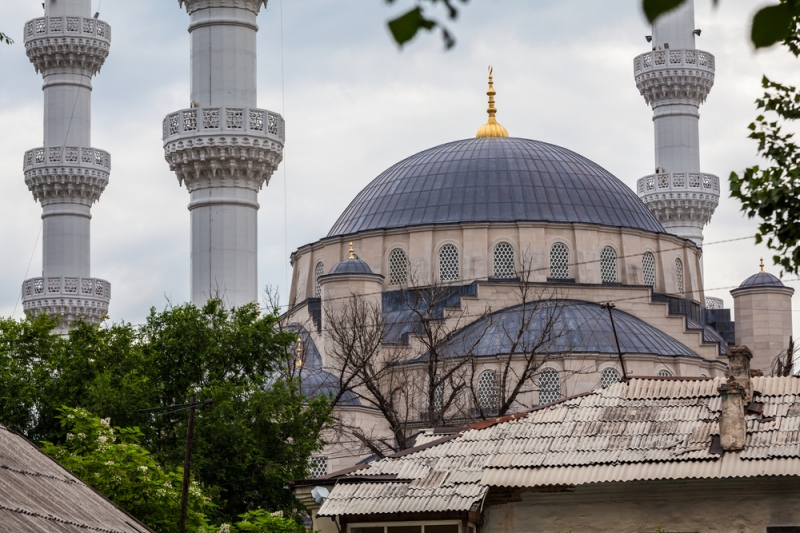
1. Bishkek
The capital of the country contains the remnants of the Soviet past, modern architecture and Asian flavor. Bars and coffee shops give way to traditional teahouses, shops with kumiss and ayran, and among fashionable young people old men in national headdresses – caps embroidered with oriental patterns – stroll leisurely.
Bishkek is called a “green” city for its large number of parks and gardens. In the center of the capital there is a long and wide Erkindik Boulevard with old tall oak trees and a year-round outdoor art gallery where you can buy paintings by local artists. Nearby is Oak Park – the central and oldest park in the city. Some trees here are over a hundred years old. The park houses St. Nicholas Church, an architectural monument of the 19th century, and an open-air sculpture museum with statues made of concrete, wood and metal.
You can see the panorama of the city against the backdrop of the Tien Shan peaks from Mount Boz-Peldek, which is accessible by public transport. At its foot there is a curious attraction – the ancient Kyrgyz cemetery “Khan’s Graves”, where one of the rulers of the valley, Baytyk Khan, is buried. A stone mausoleum in the form of a domed tower was erected over his grave.
To immerse yourself in oriental life, go to the Osh bazaar. Here you can buy felt hats with patterns, bright carpets, stock up on cheap dried fruits and nuts, spices, take fresh flatbreads with a variety of patterns and try the popular national dish – kurut – from every counter. The Kyrgyz take these dry, salted, fermented milk balls with them for long periods of grazing in the mountains. A nutritious and long-lasting snack. Follow their example and take a kurut for your upcoming trips to the mountains, which cover almost 90% of the country’s area.
2. Ala-Archa National Park
Ala-Archa National Park is located in the mountain gorge of the same name, just 40 kilometers from Bishkek. You can stay in the national park itself at the Ala-Archa hotel or in the houses of the mountaineering camp. The most popular route is the trail to the Ak-Sai waterfall, the glacier of the same name and the Ratsek hut, named after the Soviet climber Vladimir Ratsek, the organizer of expeditions and ascents in this region. You can walk the route lightly in one day – the round trip is 12.8 kilometers and, taking into account the ascent, will take 8-10 hours. A faster and easier option is to walk along the same trail to the Ak-Sai waterfall – it’s 8 kilometers and about 4-5 hours round trip. Along the way there are observation platforms from which breathtaking views open up.
If you decide to go to the end of the route, then you can stay overnight in the Ratsek hut – a two-story stone house, or in a tent next to it (you will be given a sleeping bag for a fee),
to make a simple climb to Teacher’s Peak at 4,500 meters above sea level the next day. To do this, you only need good hiking shoes, trekking poles and the desire to reach the top. Don’t be scared when you meet a herd of agile mountain goats – they are harmless and more afraid than you. From the top of the mountain there is a view of the steppes on one side and the Tien Shan mountain range on the other. Along with the descent, the ascent will take 5-6 hours.
3. Lake Issyk-Kul
Issyk-Kul is the second largest salt lake in the world, surrounded by the snow-capped peaks of Ala-Too. The lake never freezes, so tourists come here all year round. In winter, many hot thermal springs are available for bathing.
A huge number of resort towns, villages and sanatoriums stretch along the coast. One of the most popular resorts is the city of Cholpon-Ata with sandy beaches, mineral springs, the opportunity to go diving, snorkeling, and trekking to nearby peaks.
For solitude, head to the south coast. The infrastructure here is less developed than in the north, but there are empty, quiet beaches and untouched nature.
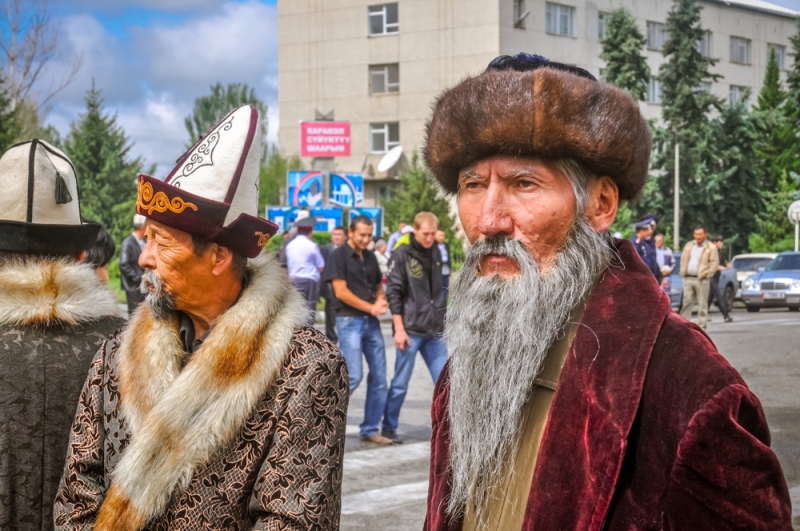
City residents in national costumes
4. Karakol
The city is located 12 kilometers from the coast of Lake Issyk-Kul, at the foot of the Terskey-Ala-Too ridge. It attracts travelers not only with its picturesque mountain views, but also with historical sights. Russian traveler and naturalist, Asian explorer Nikolai Przhevalsky, who died on the way to Karakol during his fifth expedition in Central Asia, was buried near Karakol in 1888. Next to the grave there is a Przhevalsky Museum, where you can learn about the life and travels of the geographer, and see exhibits he brought from his expeditions.
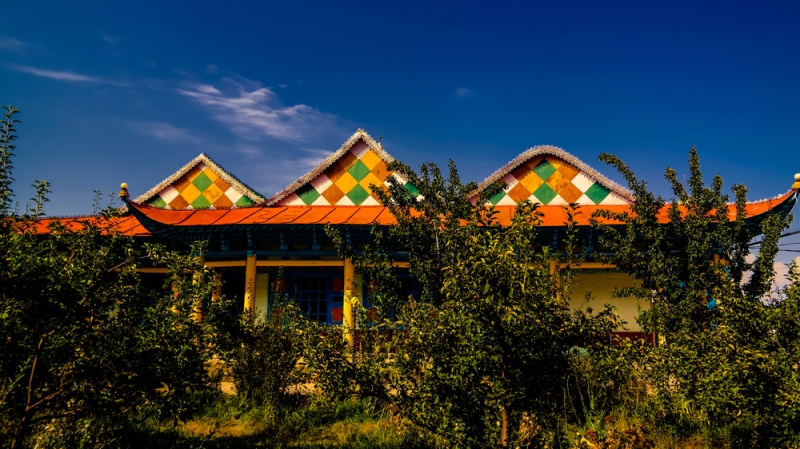
Another attraction of Karakol is the Dungan mosque. The Dungans are a people who migrated to Central Asia from China in the 1880s. The Chinese-style mosque, more like a Buddhist temple, was built more than a hundred years ago. To complete your cultural journey through Karakol, visit the late 19th century wooden Holy Trinity Cathedral, richly decorated with carvings.
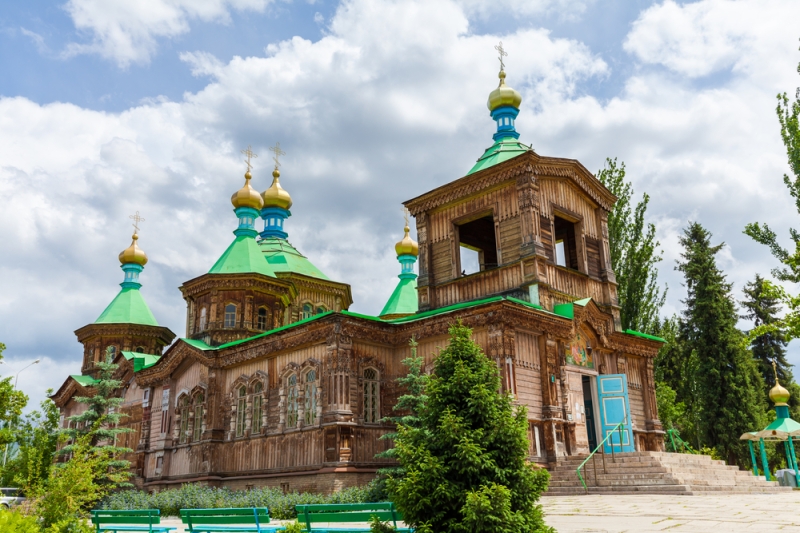
Among lovers of active recreation, Karakol is known for its ski resort of the same name. The mild climate – in winter the temperature rarely drops below minus 5 degrees – and a large amount of snow make skiing on the slopes of the Tien Shan comfortable and popular among tourists. From an altitude of 3,040 meters above sea level, where the lift goes, views of Issyk-Kul and the nearest five-thousanders open up.
5. Canyon “Fairy Tale”
The Skazka Canyon is located on the southern shore of Issyk-Kul, 4 kilometers from the village of Tosor. Under the influence of the wind, the rocks formed stone labyrinths, walls and towers, and some took the shape of animals and mythical creatures. The bright orange, and at sunset the fiery red color of the rocks is reminiscent of the famous Grand Canyon in the USA.
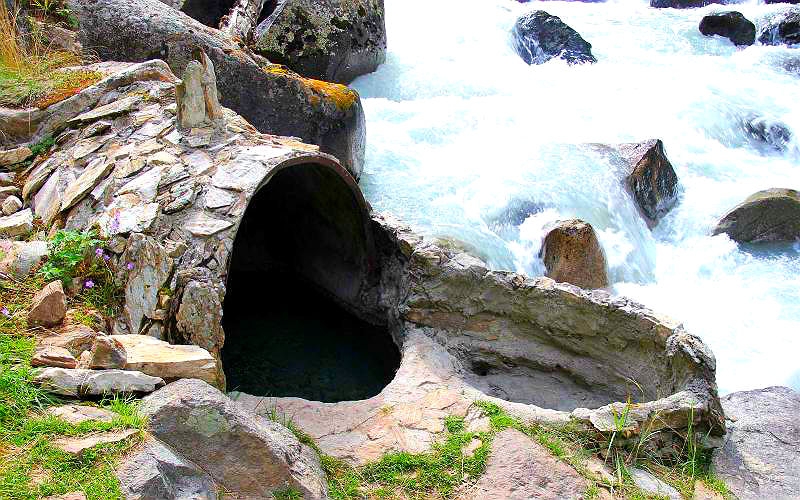
6. Radon and hydrogen sulfide thermal springs in the Altyn-Arashan gorge
“Altyn Arashan” is translated from Kyrgyz as “Golden Source”. Radon and hydrogen sulfide thermal springs in the gorge are famous for their healing properties and are especially popular among foreign tourists.
It is better to go here for a few days. The easiest way to get to the Arashan resort in the upper reaches of the river of the same name is by purchasing a ready-made tour in Karakol. You can get to the resort yourself by rented SUV or by public transport to the village of Ak-Suu, and from there walk 4 — 5 o’clock. The long journey will be rewarded with hot baths at an altitude of 2,600 meters, surrounded by mountain scenery. In addition to paid swimming pools, there is a small free bath with hot water almost in the river itself, as well as free natural baths right in the rocks.
Lovers of active recreation can go from Arashan to the high-mountainous lake Ala-Kol or to small nearby lakes within a couple of hours’ walk. There are many beautiful waterfalls near the resort.
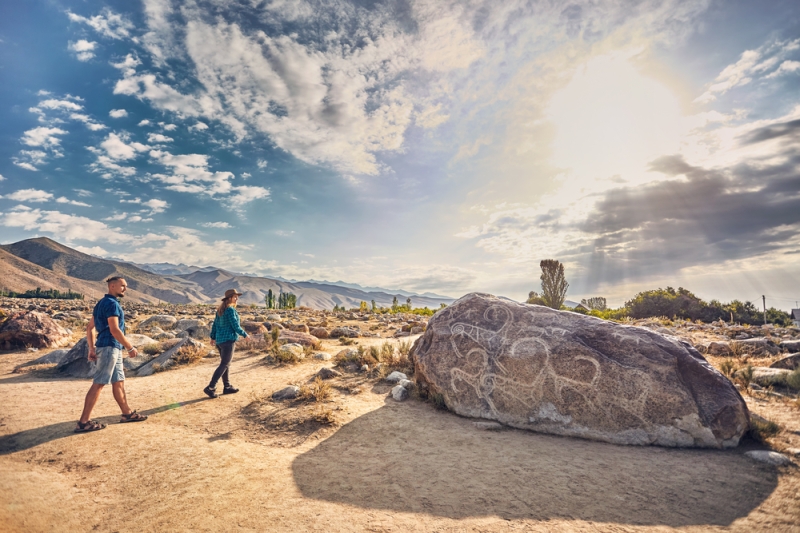
7. Museum of Petroglyphs
The open-air museum is a “garden of rocks” that were once chaotically brought by a glacier to the foot of the Tien Shan foothills. Many boulders contain ancient rock paintings of animals and hunting scenes dating back to the second millennium BC. Historians associate these paintings with religious rituals. In 2002, with the assistance of specialists from Germany, the petroglyphs were restored. In addition to rock paintings, the museum displays Turkic stone sculptures – balbals, and relics of ancient stone walls.
It is believed that it is better to go to the museum early in the morning or late in the evening, when the outlines of ancient drawings are clearly visible in the rays of the rising and setting sun.
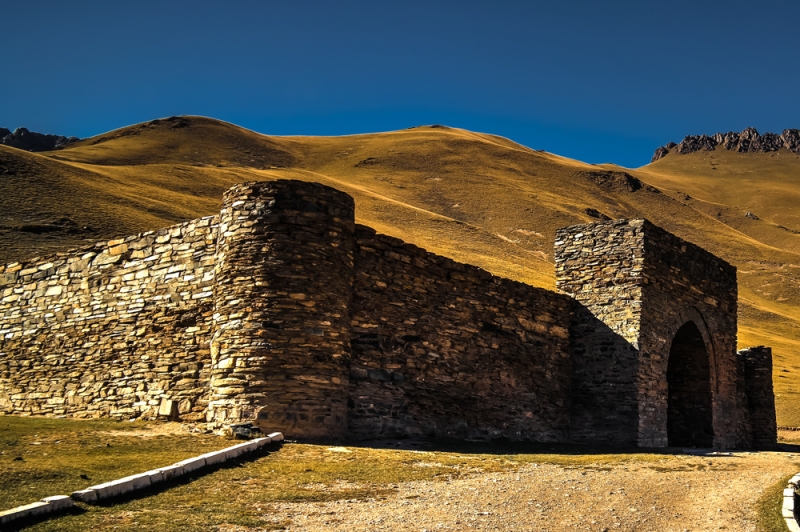
8. Caravanserai Tash Rabat
The mystical and unique medieval monument Tash-Rabat is located at an altitude of 3,000 thousand meters above sea level in the Kara-Koyun gorge. The entire structure – even the roof – is made of stone and lime. Inside there is a labyrinth connecting 31 rooms. Moreover, most of them do not have a single window. Many passages and secret exits have been preserved under the fortress. According to one version, the building served as a Nestorian monastery, lost in a mountain gorge far from the Gentiles. Another version is that Tash Rabat served as an inn, a hotel for merchants and travelers along the roads of the Great Silk Road.
You can only get here by car, so it is better to purchase an organized tour. You won’t have to spend the night in a “medieval hotel” – several guest yurts have been built nearby especially for tourists.
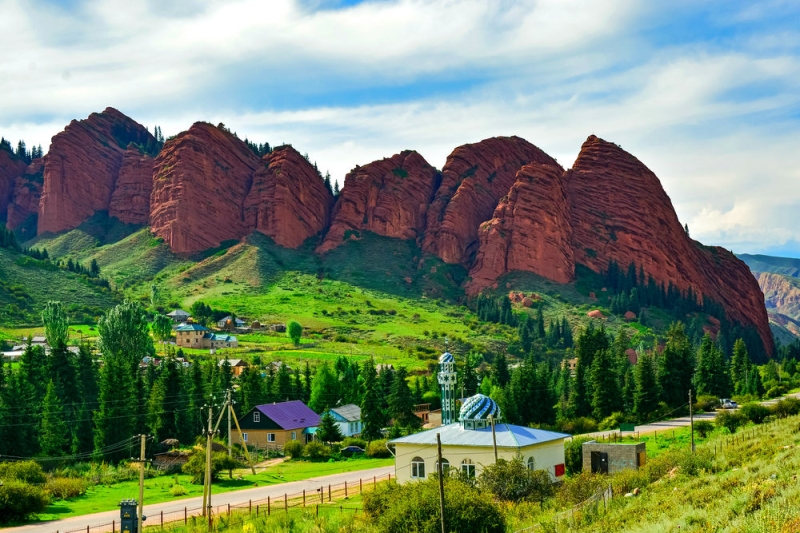
9. Jety-Oguz Gorge
The main attraction of the gorge, located on the southern shore of Issyk-Kul, is the Rocks of the Seven Bulls. Large brick-colored rocks, lined up in a long chain, really resemble bulls lying on the ground. There is a sad story connected with them – the evil khan sacrificed seven bulls at the wake of his beloved, whom he himself killed so that she would not go to another. The blood she shed stained the bodies of the animals, and they turned into majestic rocks. In addition to this legend, the first thing travelers encounter in the gorge is the huge “Broken Heart” rock, also red.
From the gorge you can walk or take a horseback excursion to the Maiden’s Hair waterfall. Another popular local attraction is the resort of the same name, known for its thermal springs and healing mud. In Soviet times, astronauts underwent rehabilitation here after flights, and now the resort is open to everyone.
10. High mountain pastures “jailoo”
From Kyrgyz “jailoo” is translated as “mountain pasture”. Relatively recently, a new and now fashionable direction among wealthy tourists has developed in Kyrgyzstan – “jailoo tourism.” You are taken to a high-mountain pasture, where you spend the night in a real shepherd’s yurt, wash in an icy mountain river, roast a sheep over the fire, which the owners will slaughter especially for you, drink kumiss – in general, live the traditional life of the Kyrgyz nomads. Not everyone will decide to undertake such an experiment, but whoever does must be prepared to pay a decent amount for it. The cost of such a tour often depends on the number of people in the group – the more there are, the cheaper. The average price per person in a group of two or three participants for several days starts from about 35 thousand rubles (including transfer to jailoo). The most popular jailoos in Kyrgyzstan, where tourists are taken, are in the Semenovsky gorge, on Lake Son-kul, jailoo Sarala-Saz, Zhaman Echki, Kilemche.
Searching for a hotel, booking a room and paying will not take much time if you do it on the website or in the OneTwoTrip application.
Text author: Gaisina Denmark

